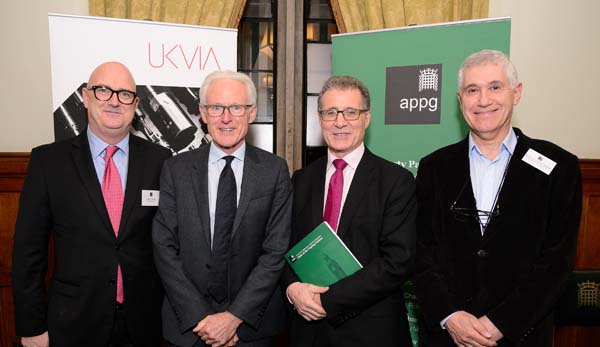A new all-parliamentary group report aims to dispel some of the unhelpful myths about vaping.
By George Gay

There was something sinister about one piece of information contained in an all-party parliamentary group (APPG) report on vaping that was officially launched by the group’s chairman, Member of Parliament Mark Pawsey, at an event at the U.K.’s Houses of Parliament on Nov. 20, 2017.
As other vaping reviews have done before, the APPG report, “State of the Vaping Nation,” described how misinformation about the health impacts of vaping was rife and how, as a consequence, more people than in the past were coming to believe, erroneously, that vaping and smoking were equally risky undertakings. As Pawsey says in his foreword: Today, just over 13 percent of people in the U.K. know what are the relative risks of vaping and smoking, whereas four years ago 21 percent knew. That is an unhelpful trend with serious consequences.
Before reading the report, I had generally assumed that this misinformation and its acceptance by a large swath of the population was down to researchers carrying out well-intentioned but flawed investigations into vapor products and the most lurid findings of these investigations being picked up by a section of the media that long ago convinced itself it could float only on a sea of shock, no matter how degraded that sea had become with its plastic news. Even some normally well-adjusted media outlets are unable to resist the siren calls of these lurid vaping headlines because they seem unable or unwilling to judge each subject on its merits. They have a mindset that, understandably, says the tobacco industry did bad things in the past, but that goes on to assume, unreasonably, that everything the industry becomes involved in, including vaping, also must be bad. This is despite their being willing uncritically to report the activities and opinions of financial institutions, car manufacturers and pharmaceutical companies.
I had assumed also that the main reason why many of these vaping investigations were flawed was because the researchers didn’t understand the products they were studying, which, in fairness, have been around for only a relatively short time. In any case, I thought, what can you expect when, it seems, few of the researchers who look into the consumption of tobacco and nicotine have ever used such products?
So I was shocked to learn from the report that I had been naive—that at least some of the findings of these investigations were the results of “tricks” being played by the researchers. One of the contributors to the report, Peter Hajek, a professor of clinical psychology and the director of the tobacco dependence research unit at the Wolfson Institute of Preventive Medicine at Queen Mary University of London, said that an increasing number of smokers in the U.K. believed that vaping was as dangerous as smoking and that misinformed health professionals and regulators continued to believe that e-cigarettes lured children into smoking.
Hajek said the misinformation was based on several standard and repeated “tricks.” Some of these tricks were elaborate, but most were simple, and he gave as an example of the latter the ploy by which any level of chemicals detected in vapor was interpreted as posing a danger, even if the levels were negligible with no possible impact on health.
What Hajek described as “dirty campaigning” had heavily influenced EU regulators, and he said there was an urgent need to counteract the current wave of misinformation. One possible approach could be an authoritative information campaign, including “adverts” in tabloids that were most often read by smokers, and that were most active in misinforming them.
Even more research?
 Presumably he is convinced that such public information campaigns would not fall foul of the EU’s Tobacco Products Directive (TPD), something of which I have no idea. But even so, the question seems to arise as to whether it would be possible to come up with a consensus around the wording of such information campaigns. Even people within the health community who are supportive of encouraging people to switch from smoking to vaping will, for whatever reason, add a rider about how more research needs to be done in respect of vaping, vapers and vapor devices. And while such statements might be well-intentioned, I think it is fair to say that they add nourishment to any seed of doubt that has been planted in the minds of smokers, who don’t need much encouragement to keep doing what they’re doing.
Presumably he is convinced that such public information campaigns would not fall foul of the EU’s Tobacco Products Directive (TPD), something of which I have no idea. But even so, the question seems to arise as to whether it would be possible to come up with a consensus around the wording of such information campaigns. Even people within the health community who are supportive of encouraging people to switch from smoking to vaping will, for whatever reason, add a rider about how more research needs to be done in respect of vaping, vapers and vapor devices. And while such statements might be well-intentioned, I think it is fair to say that they add nourishment to any seed of doubt that has been planted in the minds of smokers, who don’t need much encouragement to keep doing what they’re doing.
Indeed, another of the contributors to the report, Linda Bauld, a professor of health policy at the University of Stirling and deputy director of the UK Centre for Tobacco and Alcohol Studies, makes such a statement: “It is largely accepted by Public Health England, the Royal College of Physicians and the many in the research community that e-cigarettes are far safer than smoking, but research is needed on the long-term health impacts.”
But do we really need more research? As Hajek points out, part of the problem has to do with research, or at least the sort of dodgy research being picked up by parts of the media. Will it be possible in the future for people trying to put together information campaigns to sort the research wheat from the chaff, given that, as far as I can see, some of the seemingly dodgy research has behind it some respected names and institutions?
Perhaps there is a case for less or no research. Ordinary people, ordinary smokers, saw for themselves from the start the opportunities presented by the vapor products being offered by a bunch of startups, and they gradually spread the word through their online forums about what was good, what was not good and what should change. It could be argued that it was with the entry of the researchers, along with the experts, regulators and hangers-on that things started to go pear-shaped—that the conversion rate of smokers to vapers started to fall.
And as to long-term consequences: In my view, the only way to gather information of any value is to watch the vapers, who comprise epidemiological research on the hoof. It is not ethical to delay decisions about vaping while we wait for long-term research because vaping is the long-term research. And when we talk of long term, we have to realize that we mean a very long time. Every vaper who has come from smoking will have a different smoking history, and trying to put these people into groups from which valid health impact conclusions might be drawn is surely years and even decades off, unless of course something catastrophic is going to show up.
Well-researched
The APPG report, which has clearly been well-researched over several years and which is to be welcomed, is positive on the huge potential benefits that vaping offers in respect of replacing smoking without underestimating the challenges that realizing those benefits are going to throw up. It is being forwarded to relevant government departments and agencies, and it has been handed to the parliamentary Science and Technology Committee, which has been conducting an inquiry into e-cigarettes and which was still taking evidence when the APPG report was launched at the November event attended by the committee’s chairman, Member of Parliament Norman Lamb.
The report makes five recommendations:
- The government and public health bodies should immediately start a continuous program to accurately communicate the positive public health message of vaping to the remaining 7 million smokers in the U.K.
- The APPG calls upon the government to urgently deliver the commitment in the Tobacco Control Plan to review vapor regulation, in particular the disproportionate aspects of Article 20 of the TPD that effectively put vaping in the same bracket as smoking.
- The APPG recommends that the government adopt a wider collaborative approach to policy creation involving all stakeholders, including the regulators, scientific and public health experts, and the industry.
- Trading standards must ensure that current vaping regulations, particularly the product standards of the TPD, are consistently and rigorously enforced.
- The government should review and consider the steps taken by devolved authorities in Scotland and Wales to develop the enforcement powers of regulators.
I would have liked to have seen the first recommendation worded differently so that the government was being urged simply to communicate accurate public health messages about vaping, whatever they were, so as to acknowledge that some people are not convinced about the efficacy of vaping products and to indicate that their messages will be given an airing if they prove to be valid—not the result of tricks. And I would have liked to have seen vapers specifically named as stakeholders in the third recommendation, especially since the report does include the voice of a vaper, Sarah Jakes, who is secretary of the New Nicotine Alliance, a group dedicated to improving public health through a greater understanding of new nicotine products and their uses.
But these are merely quibbles about what is a good, authoritative report by a group that has consulted widely. The report looks at everything from the growing sophistication of vapor products and the retail environment in which they are offered for sale to research, advertising and communications, consumer perceptions, regulations good and bad, the role of government, the value of the vaping industry to the U.K. economy, and vaping in public places. One section of the report that I think will give pause to just about everyone who reads it tells how the U.K. Medicines and Healthcare products Regulatory Agency estimates that the value of the health gains associated with a single successful quit attempt is £74,000. “Even applying simple arithmetic shows that the smokers who have switched to vaping, and no longer smoke, already represent savings to the U.K. of more than £111 billion,” the report says.
More to come
 Pawsey said in his foreword that it is intended that the APPG’s “State of the Vaping Nation” would be the first of a series of reports designed to educate and inform parliamentarians in an area of consumer policy that affected many thousands of people in the U.K. This is good news because vaping is developing fast, and we all need to keep abreast of the developments. One of the subjects I should like to see the group tackle next is that to do with heat-not-burn (HnB) products. This would be a more difficult subject for the group, I would imagine, because it might break the consensus that has generally formed around e-cigarettes that deliver nicotine but contain no tobacco. Manufacturers, who like the business model that HnB devices offer, might find themselves more at odds with some researchers over these products.
Pawsey said in his foreword that it is intended that the APPG’s “State of the Vaping Nation” would be the first of a series of reports designed to educate and inform parliamentarians in an area of consumer policy that affected many thousands of people in the U.K. This is good news because vaping is developing fast, and we all need to keep abreast of the developments. One of the subjects I should like to see the group tackle next is that to do with heat-not-burn (HnB) products. This would be a more difficult subject for the group, I would imagine, because it might break the consensus that has generally formed around e-cigarettes that deliver nicotine but contain no tobacco. Manufacturers, who like the business model that HnB devices offer, might find themselves more at odds with some researchers over these products.
My reading of the situation at the moment is that HnB products might encourage more smokers to switch to vaping than e-cigarettes do, especially in some markets, but that they will prove to be riskier than are e-cigarettes. So should a trade-off be made, and, if so, where? How many notches down the risk continuum are we prepared to let an alternative product sit if it is cranking up the consumer acceptance level? And what of the apparently critical communication? This seems to work if you can say Product B is 95 percent less risky than is Product A, but what happens to your message if you have to say 75 percent less risky, or 50 percent less risky? There is also a need to look at some of the details, such as the use of flavors and the tricky question of addiction. How, if at all, do they alter the picture?
Finally, I would like to see the group, for which the UK Vaping Industry Association provides the secretariat, investigate who are the people using research tricks to put vaping in a bad light. We need to know who they are, why they are doing what they are doing and who is funding them. We need to name and shame. After all, what they are doing is no more acceptable than some of the tricks the tobacco industry pulled in the past, and it is not without serious consequences.












